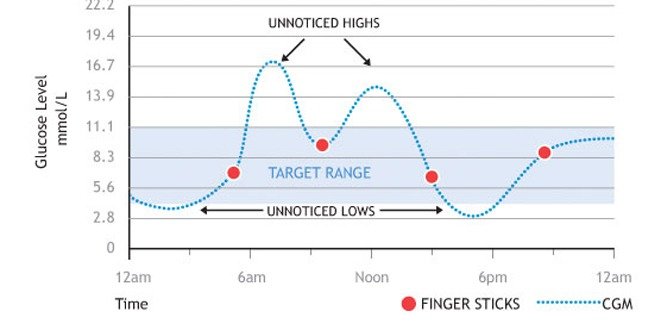
What is continuous glucose monitoring?
Continuous glucose monitoring (CGM, for short) is one of the most exciting tools for diabetes management that has been introduced over the past few years. CGM is a method of detecting trends and patterns in blood glucose that is more effective than traditional self monitoring of blood glucose (SMBG) with a blood glucose meter.
Instead of using blood, a CGM system uses interstitial fluid (the clear fluid that surrounds the cells in your body) to determine a glucose value. A sensor is placed just under the skin which allows the CGM system to provide users with nearly continuous readouts of glucose values.
What are the components of a CGM system?
A CGM system has three main parts:
1. The sensor is a disposable device that contains an electrode and a little “tail” that is inserted under your skin. It’s usually inserted in the abdomen, and for children can also be placed in the tissue above your buttock.The sensor measures the glucose level in your interstitial fluid (also called tissue fluid), and then passes that information along to the transmitter.
2. The transmitter is directly connected to the sensor, and sends information about glucose levels via radio waves from the sensor to the receiver, which is similar in size to a paging device.
3. The receiver shows your glucose level currently as well as over the last few hours. The receiver updates the information from the transmitter every 5 minutes, which means that it will show any trends and patterns in your blood glucose levels, i.e. whether they’re going up or down.
Blood glucose testing is neither a convenient nor cost effective method of tracking glucose trends and patterns continuously. However, a CGM system can do that work for you, because it continuously reads your glucose levels, and displays the results on the receiver, which uses “up” and “down” trending arrows to show any changes in your glucose levels.
CGM works with fingerstick testing
A traditional blood glucose meter uses the information from a fingerstick test for a blood glucose value, which represents only a particular moment in time. CGM monitors interstitial glucose continuously, to let you see what’s happening between fingerstick tests. That way, you can watch for glucose trends and patterns that you may not have been able to see before.
CGM doesn’t replace fingerstick testing; instead, it works with it. With trending graphs and directional arrows, the idea is to use CGM to determine the direction your glucose is headed– and how fast– and then use your fingerstick test to calculate an appropriate insulin dose. It also allows you to see the pattern of your glucose control for 7 days. This can help you make an overall change in your diabetes management.
See above figure 1. CGM vs. fingersticks

